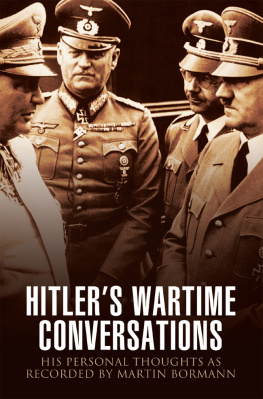

MARTIN
BORMANN
NAZI IN EXILE
By Paul Manning
To my wife, Peg, and to our four sons,
Peter, Paul, Gerald and John, whose
collective encouragement and belief in
this book as a work of historic impor-
tance gave me the necessary persistence
[FACSIMILE ELECTRONIC EDITION 2005]
and determination to keep going.
First edition
Copyright 1981 by Paul Manning
All rights reserved. No part of this book may be
reproduced in any form except by a newspaper
or magazine reviewer who wishes to quote
brief passages in connection with a review.
Queries regarding rights and permissions
should be addressed to:
Lyle Stuart Inc.,
120 Enterprise Ave., Secaucus, N. J. 07094
Published by Lyle Stuart Inc.
Published simultaneously in Canada by
Musson Book Company, a division of
General Publishing Co. Limited, Don Mills, Ont.
Manufactured in the United States of America
Library of Congress Cataloging in Publication Data Manning, Paul.
Martin Bormann, Nazi in exile.
Includes index.
1. Bormann, Martin, 1900-1943[?]. 2. National
socialismBiography. 3. War criminalsGermany
Biography. I. Title.
DD247.B65M36 943.086'092'4 [B] 81-5696
ISBN 0-8184-0309-8
AACR2
ACKNOWLEDGMENTS
To Allen W. Dulles, for his encouragement and assurance that I was on the right track, and should keep going, after reading my German research notes in preparation for this book, during the afternoons we talked in his house on Q Street in Washington, D.C.
To Robert W. Wolfe, director of the Modern Military Branch of the National Archives in Washington, his associate John E. Taylor, and George Chalou, supervisor of archivists in the Suitland, Maryland, branch of the National Archives, whose collective assistance in my search for telling documents from both sides of World War II contributed substantially to the historical merits of this book.
To those retired agents of the U.S. Treasury Department whose reports and files brought into focus the magnitude of Martin Bormanns campaign to shift the liquid assets of Germany to neutral nations during the last months of the war.
To those German nationals who, for the sake of history and to set the record straight about the leader they believe was the mainspring of West Germanys postwar recovery, contributed to my knowledge and insights into the remarkable Bormann organization.
ILLUSTRATIONS
Following page 96:
Bormann and Hitler at Berchtesgaden.
Eva Braun when she was secretary to Hitlers personal photographer.
A party celebrating Hitlers birthday, April 20, 1938.
Four photographs of the firebombing of London taken by the author.
Nazi Reich State Security Bureau (Gestapo) SS General Heinrich Mueller.
Purported grave of General Mueller in Berlin.
Fritz Thyssen, the Ruhr industrialist and early Hitler supporter.
Following page 192:
Hans Bernd Gisevius, a German underground leader, giving testimony at Nuremberg.
Allen Welsh Dulles when he was Roosevelts personal emissary to Switzerland.
Hermann Schmitz, chief executive of ficer of I.G. Farben.
Bormanns capitulation message to Grand Admiral Doenitz.
Travel permit of Hans (Juan) Baumann, friend of Martin Bormann, from the files of the FBI.
A confidential memo from J. Edgar Hoover regarding Baumann.
A joint bank account shared by Bormann and Juan Pern.
Bormanns eldest son, Adolph.
Hermann Schmitz being sentenced at Nuremberg.
The author with Dr. Hermann J. Abs, Honorary President of Deutsche Bank A.G.
Paul Manning as a CBS news correspondent during World War II.
PREFACE
DID THE WORLD EVER REALLY KNOW MARTIN
Bormann? A man of indescribably vast power and the sole trustee of Hitlers secrets after May 1, 1945, in the Berlin bunker, Bormann continues to be the most controversial, per-plexing figure of our times. There are those who wish him dead and continue to claim he is; for were he to emerge, it would embarrass the governments that assisted in his escape, the industrial and financial leaders who benefited from his acumen and transferred their capital to neutral nations in the closing days of World War II, and the businessmen of four continents who profited from the 750 corporations he established throughout the world as depositories of money, patents, bearer bonds, and shares in blue chip industries of the United States and Europe.
There are also those who know he is not dead, and I am among those who hold this belief. When I penetrated the silence cloaking this story, after countless interviews and laborious research in German and American archives for revealing documents of World War II, I knew that the Bormann saga of flight capital and his escape to South America was really true.
It had been covered up by an unparalleled manipulation of public opinion and the media. The closer I got to the truth, the more quiet attention I received from the forces surrounding and protecting Martin Bormann, and also from those who had a direct interest in halting my investigation. Over the period of years it took to research this book, I was the object of diligent observation by squads of Gestapo agents dispatched from South America by General Gestapo Mueller, who directs all security matters for Martin Bormann, Nazi in exile, and his organization, the most remarkable business group anywhere in the secret world of today. Muellers interest in me, an American 11
journalist, confirmed the truth of my many interviews and my scribed Bormann in those last days of downfall as immune from ongoing investigation: Bormann is alive, they dont want waves, the general hysteria; calm and undismayed in the midst of mad-so they have been willing to expend immense time and money men, as though this Twilight of the Gods was no affair of in tracking me and my progress.
his, as though the sun would always rise for him, and intriguing There are also those in international government and business up to the last.
who have attempted to stop my forward movement on this inves-Martin Bormann was last seen for sure in a tank crossing the tigation. In Germany, France, England, and the United States, Weidendamm Bridge in Berlin, on the night of May 1, 1945.
too many leaders in government and finance still adhere to Then, for most of the world, he vanished.
Winston Churchills statement to his Cabinet in 1943: In Nor are the Russians convinced that Bormann died in Berlin.
wartime, truth is so precious that she should always be attended The Soviet KGB assigned a Major L. Besymenski in the late by a bodyguard of lies. For these leaders act as if the war is still 1960s to probe the death or escape of Bormann. After two on, especially when they are trying to protect their flanks, their years of painstaking investigation, his report On the Trail of wealth, and their influential peers in government, business, and Martin Bormann concluded that there was a successful escape to banking. The West German government fears this story will South America.
emerge and will do harm to its growing prestige, which is really The U.S. CIA, on the other hand, theorized that the Reichs-the one resounding victory the German nation can point to with leiter had succumbed to shellfire as he fled the bunker.
pride. Yet because they are unsure how it will be received by their Staunchly insisting this was so, the CIA, for some unexplained allies of today, and because many in the Federal Republic of policy reason, advanced, promoted, and encouraged this belief.
Next page











